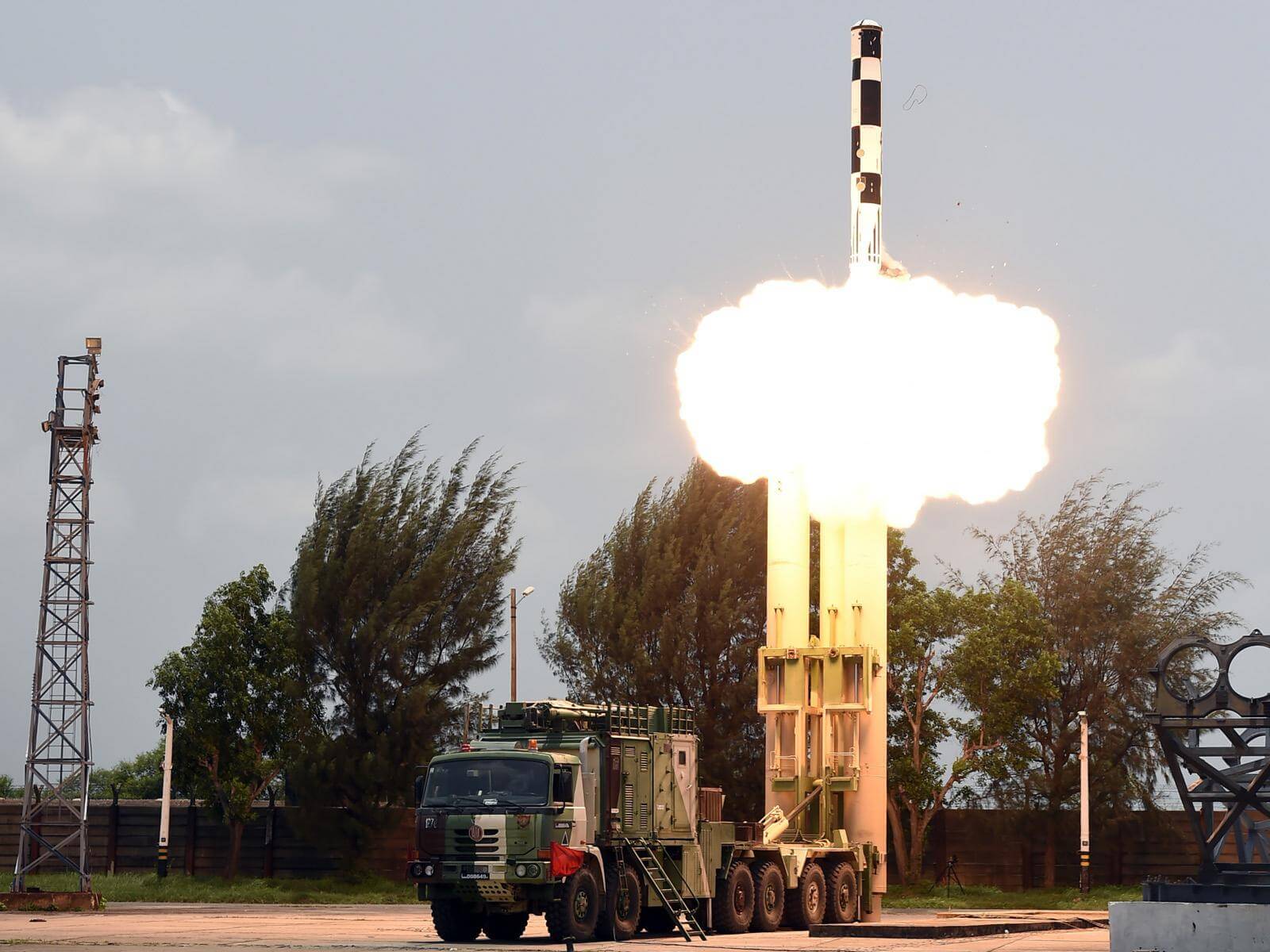
Brahmos Cruise Missile: India’s Contender In The Supersonic Vector Race
Mon, 26 Jul 2021 | Reading Time: 9 minutes

Cruise missiles are vectors that, unlike ballistic missiles, have non – rigid trajectories which can be altered in terms of direction, altitude and speed and can deliver warheads over large distances with a high degree of precision. Cruise missiles can be categorized by size, speed (subsonic/ supersonic), range, warhead and launch platform (land, air, surface ship, or submarine). The BrahMos Cruise Missile epitomizes these salient characteristics into a holistic state of the art weapon system.
Why Did India Need a Supersonic Cruise Missile?
India has long been under the cloud of collusive military threat from two belligerent nuclear powered neighbours, with at least one having ambiguous ‘nuclear red lines’, which need to be contended with. A further cause for operational concern is the robust Air Defence capabilities possessed by both neighbours, which could to a large extent neutralise threats from subsonic vectors. Add to this the maritime threat, wherein navies of both belligerents are capable of executing maritime blockades, with one of them a serious challenger to India’s heralded status as a net security provider in the Indian Ocean Region.
With this portent as a backdrop, a need was felt to create the capability for vector based precision engagements below the nuclear threshold, with reduced launch- to- target times that would obviate evasive action by the adversary. Such a vector would require to be dual-use and have the capability of launch from multiple platforms. This would enhance operational flexibility and bolster the robustness of the nuclear triad, should it be required to launch a nuclear payload. The missile would require to possess high hit/ kill probability, thus enabling disruption/ neutralisation of the adversary’s preparatory activities and High Value Targets (HVTs) that might fleetingly present themselves, including those hidden away from direct observation- all this at operational ranges beyond the tactical or immediate battlefield. An imperative requirement of range would be the ability to hit deployed military targets across our Northern Borders and into the heartland of our Western adversary, as well as maritime targets off own Eastern/ Western Seaboards and in the Northern Indian Ocean. Thus was born the requirement to develop a supersonic, dual- use precision- guided missile capable of being launched from land, air and surface/ sub- surface platforms, against targets in land, sea and air domains. Enter the BrahMos Supersonic Cruise Missile!
The BrahMos Cruise Missile Program
The Indo- Russian BrahMos Program derives its name from a combination of the names of the Brahmaputra and Moskva Rivers of the two countries and is a joint venture (JV) between the Russian Federation’s NPO Mashinostroyeniya Rocket Design Bureau (NPOM) and DRDO, with the moniker of BrahMos Aerospace. The JV was established on 12 February 1998, wherein India holds a majority 50.5% share.
The BrahMos Cruise Missile is a ‘fire and forget’, medium range, supersonic cruise missile, based on the design of the Russian P-800 Oniks Cruise Missile, developed during the Cold War against major warships. The BrahMos missile is currently the fastest supersonic cruise missile in the world and can be fired from tri- service platforms against targets in all three domains (including variants under development). The missile can fly at speeds upto Mach 2.8 (3457 km/h), depending upon the cruising altitude chosen- upto 15 km, with a low terminal altitude of 10m. These speeds lend to precision targeting, quicker engagement times, difficulty of interception and impart nine times more kinetic energy and consequent enhanced lethality to the projectile as compared to other modern sub- sonic cruise missiles. Interception is also made difficult by radar- evading stealth technology. The missile uses a canister for transportation, storage & launch, thus lending to logistics ease. The range was restricted to 290 km as Russia was a signatory to the Missile Technology Control Regime (MTCR) at the time, while India was not- thus prohibiting Russia helping a non MTCR Nation from developing missiles with ranges beyond 300 km. India joined the MTCR in June 2016, thus easing restrictions on further development. The first prototype of BrahMos was test fired on 12 June 2001. The missile has since been inducted into the three Services.
The BrahMos N-1 ship-launched variant with ability to hit maritime targets beyond the radar horizon was inducted into the Indian Navy (IN) in 2005 on INS RAJPUT, a Destroyer Class ship. The Universal Vertical Launch Module (ULVM), was successfully tested in 2008, post which the same has been configured on a number of IN warships. The Quadruple Canisterised Inclined Launcher (QCIL or QUAD) has now been designed for warships which have space constraints to accommodate a Vertical Launch Module. The submarine launched variant for sub-surface launch from a depth of 40- 50 m was successfully test fired in March 2013 and will be incorporated into the P 75 (I) submarines, which has also been elucidated in an article on India’s submarines in Chanakya Forum @ https://chanakyaforum.com/indias-submarines-towards-regional-dominance/ .
The BrahMos I Block-I (Base Variant) for the IA was inducted on 21 June 2007. On 05 September 2010, BrahMos became the first cruise missile to execute a successful steep dive at supersonic speeds, thus meeting the land- attack requirement of the IA with Block- II advanced seeker software, which gave the capability to select individual targets in a cluttered battlefield. On 12 August 2011, the Block- III variant was successfully test fired. This variant enjoys module based G3OM Navigation incorporating GPS (US), GLONASS (Russian) and GAGAN (Indian) Navigation Systems, giving the missile sub-5m accuracy! The advanced guidance software gives high manoeuverability and steep dive capability from high altitude, thus enabling engagement behind mountain features- a capability tailor made for employment along India’s mountainous borders. The missile was successfully tested with an Indian terminal guidance seeker in March 2018 and with indigenous airframe, propulsion system & power supply in September 2019, thus significantly enhancing indigenous content and conforming to the ‘Make in India’ theme. On 24 November 2020, the IA successfully test fired the missile in ‘top- attack’ configuration, thus establishing the lethality of the weapon against fortified targets.

BrahMos Mounted on Transporter Erector Launcher (TEL): Source- Wikimedia
The BrahMos-A Air Launched Cruise Missile (ALCM) provides the Indian Air Force (IAF) the capability to accurately strike land/ sea targets from beyond visual range by day/ night in all weather conditions. On 22 November 2017, the ALCM was successfully test fired from a Sukhoi- 30 MKI against a target in the Bay of Bengal. This made the IAF a pioneer in successful launch of a trisonic- class (Mach 3) missile on a maritime target. Post these trials, the IAF declared completion of integration of the ALCM on the Sukhoi- 30 MKI in December 2019. 40 Sukhoi -30 MKI are in the process of undergoing modifications for carrying the ALCM. The IAF commissioned its first squadron of BrahMos enabled Sukhoi- 30 MKI in January 2020.
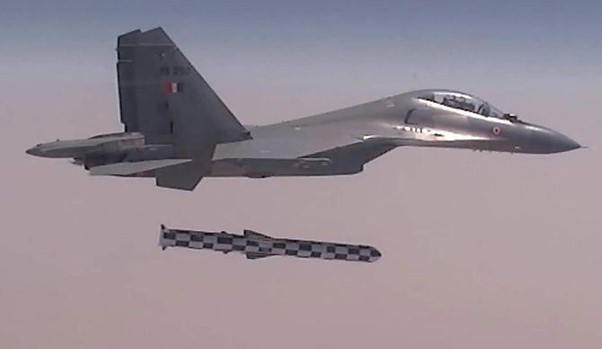

BrahMos ALCM: Source- quora/ newsroompost.com
The successful induction and deployment of the BrahMos missile in all three Services significantly enhances India’s strategic might in the region and heralds the completion of the supersonic cruise missile triad across launch platforms in all three domains.
Latest Developments and Perspective Roadmap
India becoming a signatory to the MTCR in 2016 paved the way for further development in the BrahMos Program to include variants with greater ranges and higher speeds, thus enabling India to venture into the medium range cruise missile and hypersonic missile club.
BrahMos- II. The BrahMos- II ( which is not to be confused with the Block- II variant of BrahMos- I), is a hypersonic missile ( speed > Mach 5) under development that is estimated to have a range of 600 km. The missile will have speed upto Mach 8, making it the fastest hypersonic missile currently under development in the world. It is likely to be fielded by the end of the decade. The missile has been renamed as BrahMos- II (K) in honour of former President APJ Abdul Kalam, who had urged BrahMos Aerospace to “accelerate the development of hypersonic weapons technology and field an operational missile within three to five years”.
BrahMos- NG. The BrahMos NG (Next generation) cruise missile will be 40% smaller and 50% lighter than the BrahMos- I , with a range of 290- 300 km and speed upto Mach 3.5. This will result in a significantly lesser radar cross- section, thus making detection more difficult and increasing survivability in saturated Air Defence environments. Being smaller and lighter would allow three NG variant missiles to be pylon-mounted on a single Sukhoi- 30 MKI, thus enhancing operational capability and aiding manoeuverability of the aircraft, which is somewhat affected by the single fuselage-mounted base version. This version is also suitable for arming the smaller MiG-29 K or Mirage- 2000 fighter aircraft. In the submarine- launched version, the NG missile would lend to mounting in standard torpedo tubes. The missile is likely to be ready for flight tests in the next couple of years and be ready for induction in 2024, should development progress as planned.
BrahMos- ER. The BrahMos- ER ( Extended Range), with a range of 450 km, is also at the test- firing stage, with the latest firing having taken place on 12 July this year. Development of this variant could only commence post India becoming a signatory to the MTCR. Plans also exist to enhance the range of the ALCM and surface launched version to 1500 km / 800 km respectively.
Unmanned Combat Aerial Vehicle (UCAV) Variant. Work on developing a returnable carrier variant of the BrahMos to deliver payload is also being considered. However, no development in this field has currently been reported.
India also successfully test-fired the missile from the indigenously built stealth destroyer, INS Chennai in October 2020. This is a significant stride in India’s maritime stealth- strike capability, which would allow stealthy and high speed offshore raids onto enemies littoral targets and Naval assets.

BrahMos Naval Version Fired from INS Chennai: Source- Indian Navy
How Does the BrahMos Missile Fit into Global Competition?
A comparison is herewith drawn between BrahMos and other global players, including the SCALP (currently in use by various countries in Asia and the EU), Russian Kh-101 and Chinese CX-1 Cruise Missiles. This comparison does not include hypersonic vectors like the Kalibr M of Russia or the DF- ZF Hypersonic Glide Vehicle of China, described in a previous article @ Chanakya Forum https://chanakyaforum.com/chinas-nuclear-forces-dragon-fire-or-facade/ .
The SCALP (Storm Shadow) is an Anglo- French Air to Surface Missile (ASM) developed in the mid-90s. The missile is based on the Apache anti-runway missile, and differs in that it carries a warhead rather than submunitions. The IAF, which operates the SCALP mounted on the Rafale, has also sought upgradation of the software to hit targets at upto 4000 m above sea level.
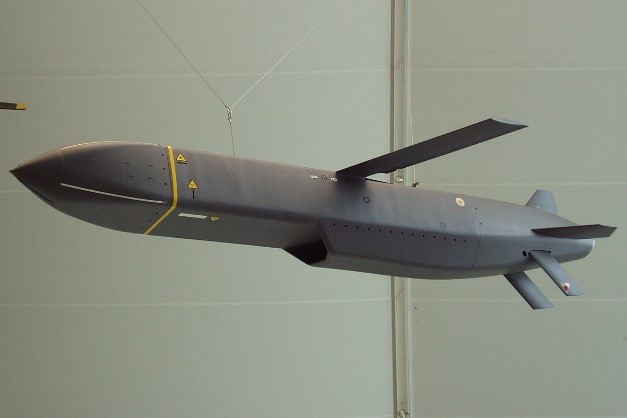
SCALP ASM: Source- Wikipedia
The Russian Kh-101 Raduga was developed as a long-range, standoff ALCM. Design commenced in the late 1980s and the missile entered service in 2012.
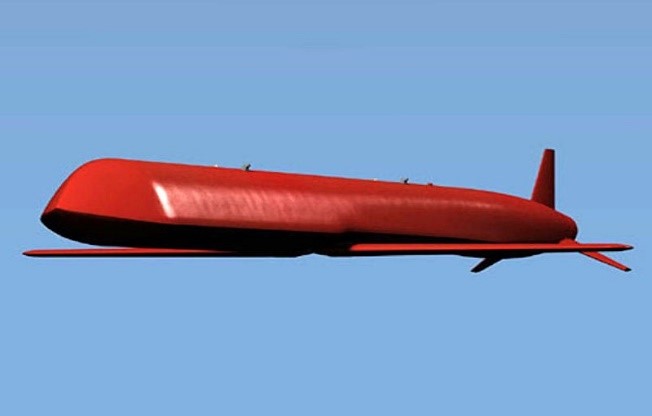
Kh- 101 Cruise Missile: Source- globalsecurity.org
The Chaoxun-1 (CX-1) is a supersonic anti-ship cruise missile which resembles the BrahMos in appearance. The missile was first displayed in November 2014. There exist the ship-borne and road-mobile versions, featuring conventional warheads. It also reportedly has a secondary land-attack function and a submarine-launched version. The CX-1 is believed to be purely for export, as its specifications meet requirements of the MTCR. Potential customers may include Pakistan and Iran, among others.
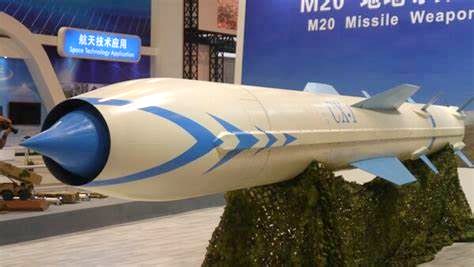
CX-1 Supersonic Cruise Missile: Source- defensenews.com

Conclusion
The BrahMos Missile Program has today evolved into a frontrunner in the global supersonic cruise missile race, with the missile offering best in class operational features of speed, multi domain employment, choice of payload, precision strike and survivability. Such is the awe presently generated in the global market, that a plethora of countries across the globe continue to express interest in procuring this missile, which endorses the perception, or rather the fact, that the BrahMos missile is truly a game changer in the modern, multi- domain battlefield.
*********************************************************************************************************

Disclaimer
The opinions expressed in this article are the author’s own and do not reflect the views of Chanakya Forum. All information provided in this article including timeliness, completeness, accuracy, suitability or validity of information referenced therein, is the sole responsibility of the author. www.chanakyaforum.com does not assume any responsibility for the same.
Chanakya Forum is now on . Click here to join our channel (@ChanakyaForum) and stay updated with the latest headlines and articles.
Important
We work round the clock to bring you the finest articles and updates from around the world. There is a team that works tirelessly to ensure that you have a seamless reading experience. But all this costs money. Please support us so that we keep doing what we do best. Happy Reading
Support Us




















POST COMMENTS (6)
The Indian Navy’s Improving Arsenal: Building Strategic Maritime Might! - Chanakya Forum
Himanshu
Ganesh Bhat
vinay menon
roshan kumar
Mukesh.Naik